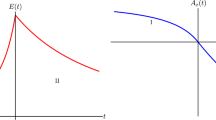Summary
The connection between Schwinger's proper-time and Feynman's path integral methods is exploited in order to obtain a space-time description of spontaneous pair creation in an external field. The relevance of classical closed trajectories in Euclidean space-time and the connection with the tunnel effect of nonrelativistic quantum mechanics are discussed.
Riassunto
Si esamina la connessione tra il metodo di Schwinger del tempo proprio e quello di Feynman dell'integrazione sui percorsi al fine di ottenere una descrizione spazio-temporale del processo di creazione spontanea di coppie in un campo esterno. Si discute l'analogia con l'effetto tunnel della meccanica quantistica non relativistica e si mette in evidenza l'importanza delle traiettorie class'che chiuse nello spazio-tempo euclideo.
Резюме
Чтобы получить пространственно-временное описание спонтанного образования пар во внешнем поле, используется связь между собственным временем Швингера и фейнмановским методом интегрирования по траекториям. Обсуждаются важность классических замкнутых траекторий в эвклидовом пространстве-времени и аналогия с туннельным эффектом нерелятивистской квантовой механики.
Similar content being viewed by others
References
See, for instance,J. Rafelski, L. P. Fulcher andA. Klein:Phys. Rep. C,38, 227 (1978), and references quoted therein.
See, for instance,P. Sikivie andN. Weiss:Phys. Rev. Lett.,40, 1411 (1978);J. E. Mandula:Phys. Rev. Lett. B,69 495 (1978).
J. Schwinger:Phys. Rev.,82, 664 (1951), See alsoJ. Schwinger:Particles, Sources and Fields, Vol. I, II (Reading, Mass. 1973).
W. Heisenberg andH. Euler:Z. Phys.,98, 714 (1936);V. Weisskopf:K. Dan. Vidensk. Selsk. Mat. Fys. Medd.,14, No. 6 (1936).
R. P. Feynman andA. R. Hibbs:Quantum Mechanics and Path Integral (New York, N. Y., 1965).
R. P. Feynman:Phys. Rev.,80, 440 (1950).
See, for instance,R. Rajaraman:Phys. Rep. C,21, 227 (1975);D. Olive, S. Sciuto andR. J. Crewther:Riv. Nuovo Cimento,2, 1 (1979).
R. P. Feynman;Phys. Rev.,74, 939 (1948).
Author information
Authors and Affiliations
Additional information
Переведено редакцией
Rights and permissions
About this article
Cite this article
Catara, F., Consoli, M. & Eberle, E. Spontaneous pair creation in an electric field: A space-time analysis. Il Nuovo Cimento B 70, 45–54 (1982). https://doi.org/10.1007/BF02814010
Received:
Published:
Issue Date:
DOI: https://doi.org/10.1007/BF02814010



